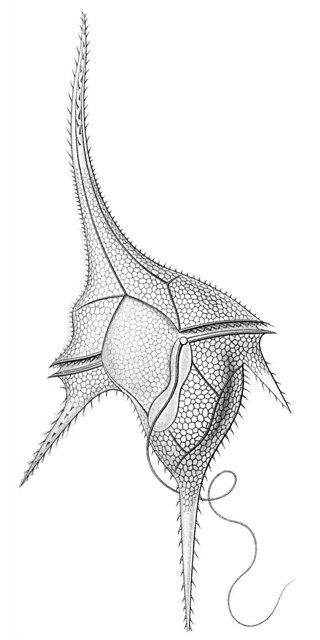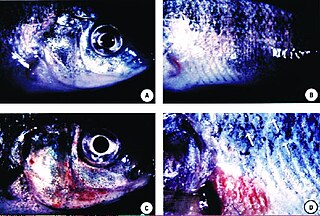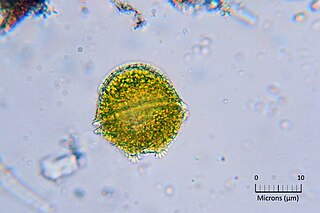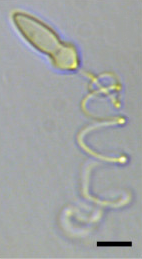
The dinoflagellates are a monophyletic group of single-celled eukaryotes constituting the phylum Dinoflagellata and are usually considered protists. Dinoflagellates are mostly marine plankton, but they also are common in freshwater habitats. Their populations vary with sea surface temperature, salinity, and depth. Many dinoflagellates are photosynthetic, but a large fraction of these are in fact mixotrophic, combining photosynthesis with ingestion of prey.

Paralytic shellfish poisoning (PSP) is one of the four recognized syndromes of shellfish poisoning, which share some common features and are primarily associated with bivalve mollusks. These shellfish are filter feeders and accumulate neurotoxins, chiefly saxitoxin, produced by microscopic algae, such as dinoflagellates, diatoms, and cyanobacteria. Dinoflagellates of the genus Alexandrium are the most numerous and widespread saxitoxin producers and are responsible for PSP blooms in subarctic, temperate, and tropical locations. The majority of toxic blooms have been caused by the morphospecies Alexandrium catenella, Alexandrium tamarense, Gonyaulax catenella and Alexandrium fundyense, which together comprise the A. tamarense species complex. In Asia, PSP is mostly associated with the occurrence of the species Pyrodinium bahamense.

Predatory dinoflagellates are predatory heterotrophic or mixotrophic alveolates that derive some or most of their nutrients from digesting other organisms. About one half of dinoflagellates lack photosynthetic pigments and specialize in consuming other eukaryotic cells, and even photosynthetic forms are often predatory.
Alexandrium fundyense is a species of dinoflagellates. It produces toxins that induce paralytic shellfish poisoning (PSP), and is a common cause of red tide. A. fundyense regularly forms massive blooms along the northeastern coasts of the United States and Canada, resulting in enormous economic losses and public health concerns.
Alexandrium tamarense is a species of dinoflagellates known to produce saxitoxin, a neurotoxin which causes the human illness clinically known as paralytic shellfish poisoning (PSP). Multiple species of phytoplankton are known to produce saxitoxin, including at least 10 other species from the genus Alexandrium.

The Gymnodiniales are an order of dinoflagellates, of the class Dinophyceae. Members of the order are known as gymnodinioid or gymnodinoid. They are athecate, or lacking an armored exterior, and as a result are relatively difficult to study because specimens are easily damaged. Many species are part of the marine plankton and are of interest primarily due to being found in algal blooms. As a group the gymnodinioids have been described as "likely one of the least known groups of the open ocean phytoplankton."

Ornithocercus is a genus of planktonic dinoflagellate that is known for its complex morphology that features considerable lists growing from its thecal plates, giving an attractive appearance. Discovered in 1883, this genus has a small number of species currently categorized but is widespread in tropical and sub-tropical oceans. The genus is marked by exosymbiotic bacteria gardens under its lists, the inter-organismal dynamics of which are a current field of research. As they reside only in warm water, the genus has been used as a proxy for climate change and has potential to be an indicator species for environmental change if found in novel environments.

Alexandrium is a genus of dinoflagellates. It contains some of the dinoflagellate species most harmful to humans, because it produces toxic harmful algal blooms (HAB) that cause paralytic shellfish poisoning (PSP) in humans. There are about 30 species of Alexandrium that form a clade, defined primarily on morphological characters in their thecal plates.
Alexandrium monilatum is a species of armored, photosynthetic, marine dinoflagellates. It produces toxins that, when present in high concentrations as "red tides", can kill fish and reduce growth rates of shellfish.
Alexandrium catenella is a species of dinoflagellates. It is among the group of Alexandrium species that produce toxins that cause paralytic shellfish poisoning, and is a cause of red tide. ‘’Alexandrium catenella’’ is observed in cold, coastal waters, generally at temperate latitudes. These organisms have been found in the west coast of North America, Japan, Australia, and parts of South Africa.

Cochlodinium polykrikoides is a species of red tide producing marine dinoflagellates known for causing fish kills around the world, and well known for fish kills in marine waters of Southeast Asia. C. polykrikoides has a wide geographic range, including North America, Central America, Western India, Southwestern Europe and Eastern Asia. Single cells of this species are ovoidal in shape, 30-50μm in length and 25-30μm in width.
Luciella masanensis is a species of heterotrophic marine dinoflagellates.

An ocelloid is a subcellular structure found in the family Warnowiaceae (warnowiids), which are members of a group of unicellular organisms known as dinoflagellates. The ocelloid is analogous in structure and function to the eyes of multicellular organisms, which focus, process and detect light. The ocelloid is much more complex than the eyespot, a light-sensitive structure also found in unicellular organisms, and is in fact one of the most complex known subcellular structures. It has been described as a striking example of convergent evolution.

The Warnowiaceae are a family of athecate dinoflagellates. Members of the family are known as warnowiids. The family is best known for a light-sensitive subcellular structure known as the ocelloid, a highly complex arrangement of organelles with a structure directly analogous to the eyes of multicellular organisms. The ocelloid has been shown to be composed of multiple types of endosymbionts, namely mitochondria and at least one type of plastid.

A nematocyst is a subcellular structure or organelle containing extrusive filaments found in two families of athecate dinoflagellates, the Warnowiaceae and Polykrikaceae. It is distinct from the similar subcellular structures found in the cnidocyte cells of cnidarians, a group of multicellular organisms including jellyfish and corals; such structures are also often called nematocysts, and cnidocytes are sometimes referred to as nematocytes. It is unclear whether the relationship between dinoflagellate and cnidarian nematocysts is a case of convergent evolution or common descent, although molecular evidence has been interpreted as supporting an endosymbiotic origin for cnidarian nematocysts.

The Polykrikaceae are a family of athecate dinoflagellates of the order Gymnodiniales. Members of the family are known as polykrikoids. The family contains two genera: Polykrikos and Pheopolykrikos.

Erythropsidinium is a genus of dinoflagellates of the family Warnowiaceae.

Dinoflagellates are eukaryotic plankton, existing in marine and freshwater environments. Previously, dinoflagellates had been grouped into two categories, phagotrophs and phototrophs. Mixotrophs, however include a combination of phagotrophy and phototrophy. Mixotrophic dinoflagellates are a sub-type of planktonic dinoflagellates and are part of the phylum Dinoflagellata. They are flagellated eukaryotes that combine photoautotrophy when light is available, and heterotrophy via phagocytosis. Dinoflagellates are one of the most diverse and numerous species of phytoplankton, second to diatoms.

Polykrikos is one of the genera of family Polykrikaceae that includes athecate pseudocolony-forming dinoflagellates. Polykrikos are characterized by a sophisticated ballistic apparatus, named the nematocyst-taeniocyst complex, which allows species to prey on a variety of organisms. Polykrikos have been found to regulate algal blooms as they feed on toxic dinoflagellates. However, there is also some data available on Polykrikos being toxic to fish.

The cortical alveolum is a cellular organelle consisting of a vesicle located under the cytoplasmic membrane, to which they give support. The term "corticate" comes from an evolutionary hypothesis about the common origin of kingdoms Plantae and Chromista, because both kingdoms have cortical alveoli in at least one phylum. At least three protist lineages exhibit these structures: Telonemia, Alveolata and Glaucophyta.













